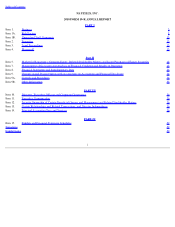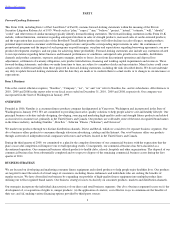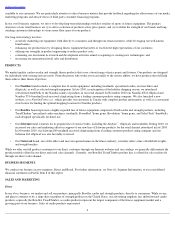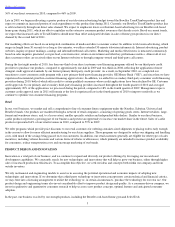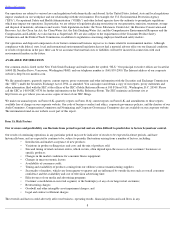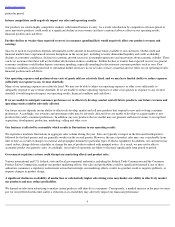Nautilus 2010 Annual Report Download - page 13
Download and view the complete annual report
Please find page 13 of the 2010 Nautilus annual report below. You can navigate through the pages in the report by either clicking on the pages listed below, or by using the keyword search tool below to find specific information within the annual report.
Table of Contents
a timely manner. As a result, we rely on the free flow of goods through open and operational ports worldwide. Labor disputes at various ports
create significant risks for our business, particularly if these disputes result in work slowdowns, lockouts, strikes or other disruptions during our
peak importing seasons. Any of these factors could result in reduced sales, canceled sales orders and unanticipated inventory accumulation and
have a material adverse effect on our operating results, financial position and cash flows.
Unpredictable events and circumstances relating to our international operations, including our use of non-U.S. manufacturers, could
have a material adverse effect on our business.
A portion of our revenue is derived from sales outside the U.S., primarily in Canada. In addition, substantially all of our products are
manufactured outside of the U.S. Accordingly, our future results could be materially adversely affected by a variety of factors pertaining to
international trade, including: changes in a specific country's or region's political or economic conditions; trade restrictions; import and export
licensing requirements; changes in regulatory requirements; additional efforts to comply with a variety of foreign laws and regulations; and
longer payment cycles in certain countries, thus requiring us to finance customer purchases over a longer period than those made in the U.S. In
addition, we rely on the performance of our employees located in foreign countries. Our ability to control the actions of these employees may be
limited by the laws and regulations in effect in each country. Changes in any of the above factors could have a material adverse effect on our
operating results, financial position and cash flows.
Currency exchange rate fluctuations could result in higher costs and reduced margins.
We have significant sales outside of the United States, primarily in Canada. As a result, we conduct transactions in various currencies which
increase our exposure to fluctuations in foreign currency exchange rates relative to the U.S. dollar. Our international revenues and expenses
generally are derived from sales and operations in non-U.S. currencies, and these revenues and expenses could be affected by currency
fluctuations. Currency exchange rate fluctuations could also result in higher costs for our products, or could disrupt the business of independent
manufacturers that produce our products, by making their purchases of raw materials more expensive and more difficult to finance. Therefore,
our future financial results could be significantly affected by the value of the U.S. dollar in relation to the foreign currencies in which we, our
customers or our suppliers conduct business. Currency fluctuation is one of the many variables we continually monitor around the world,
including commodity costs, labor inflation, trade laws, and product sourcing. China recently announced that it would reform its Renminbi
exchange rate regime in order to increase flexibility to exchange rate fluctuations, which may cause product prices to increase in the future.
Historically, as we have experienced increases in manufacturing costs, we have been successful in increasing the selling price of our products to
mitigate the long-term impact, and expect to be able to adjust our pricing in response to these increases. If we are unable to increase our selling
prices to offset such cost increases, or if such increases have a negative impact on sales of our products, our revenues and earnings would be
negatively impacted.
Failure or inability to protect our intellectual property could significantly harm our competitive position.
Protecting our intellectual property is an essential factor in maintaining our competitive position in the health and fitness industry. If we do not,
or are unable to, adequately protect our intellectual property, our sales and profitability may be adversely affected. We currently hold
approximately 800 patents and trademarks worldwide and have approximately 100 patent and trademark applications pending in the United
States. However, our efforts to protect our proprietary rights may be inadequate, and applicable laws provide only limited protection.
Trademark infringement or other intellectual property claims relating to our products could increase our costs.
Our industry is susceptible to litigation regarding trademark and patent infringement and other intellectual property rights. We could become a
plaintiff or defendant in trademark and patent infringement claims or claims of breach of license. The prosecution or defense of intellectual
property litigation is both costly and disruptive of the time and resources of our management, even if the claim or defense against us is without
merit. We could also be required to pay substantial damages or settlement costs to resolve intellectual property litigation or related matters.
Future impairments of intangible assets could negatively impact our operating results.
We had goodwill of $2.9 million and other intangible assets of $18.8 million as of December 31, 2010. We recognized impairment charges of
$5.9 million in 2009 related to intangible assets of our continuing operations. Any future impairment charges, if significant, could materially and
adversely affect our operating results. An unexpected decline in revenue, changes in market conditions, changes in competitive products or
technologies or a change in management's intentions regarding utilization of intangible assets could lead to further impairment charges.
11



